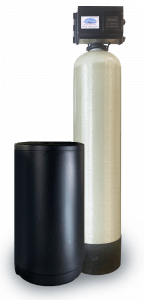Groundwater Contamination: Nitrate

Detecting and Treating Nitrate in Water
At U.S. Water, we believe in the importance of water that is not only abundant but also pure. Nitrate contamination in well water is a critical issue that can impact both the quality of your water and the health of your loved ones.
What is nitrate?
Nitrate is a type of compound found naturally in the environment and can also be introduced through human activities like agriculture and industrial processes.
The Environmental Protection Agency (EPA) has set the limit for nitrate in drinking water at 10 milligrams per liter (mg/L) to protect human health. This limit is established to prevent health problems, particularly in infants and pregnant women.
Where does it come from?
 Agricultural Runoff: Fertilizers and manure used in agriculture can introduce nitrates into the groundwater.
Agricultural Runoff: Fertilizers and manure used in agriculture can introduce nitrates into the groundwater.
Septic Systems: Poorly maintained or failing septic systems may contribute to nitrate contamination.
Industrial Discharges: Certain industries may release nitrates into the environment, impacting water sources.
Is it a health hazard?
 High nitrate levels in drinking water, when consumed, can convert to nitrite in the body. This process interferes with the blood’s oxygen-carrying capacity, leading to a condition known as methemoglobinemia or “blue baby syndrome.”
High nitrate levels in drinking water, when consumed, can convert to nitrite in the body. This process interferes with the blood’s oxygen-carrying capacity, leading to a condition known as methemoglobinemia or “blue baby syndrome.”
This is particularly concerning for infants and pregnant women. However, nitrate in tap water is a health risk for people of all ages. For adults, prolonged exposure to high nitrate levels can increase the risk of certain cancers, thyroid problems, and other health issues.
When should I test?
Regular testing for nitrate is essential, especially for those reliant on well water. The U.S. Environmental Protection Agency (EPA) recommends annual testing for nitrate levels, and more frequent testing for pregnant individuals or those with infants.
If my water tests positive, what should I do next?
If your water tests positive for elevated nitrate levels, taking action is essential. Here are the recommended steps:
Stop Drinking It: Stop drinking the water until the issue is resolved. Use alternative water sources for drinking and cooking.
Contact U.S. Water:Based on the level of the nitrate found within your water, we can help you determine the best course of treatment for your water supply.
U.S. Water’s Nitrate Treatment Options:
Nitrate Shield:OurNitrate Shieldsystem utilizes ion exchange technology to effectively remove nitrates from your water, providing a reliable and efficient solution.
Reverse Osmosis:U.S. Water’sReverse Osmosissystems are another proven method to reduce nitrate levels, ensuring the delivery of clean and safe drinking water.


 Block nitrate and nitrite from entering your home’s water with Nitrate Shield exclusively from U.S. Water.
Block nitrate and nitrite from entering your home’s water with Nitrate Shield exclusively from U.S. Water.
Not sure which product you need?
TALK TO ONE OF OUR WATER CONSULTANTS

